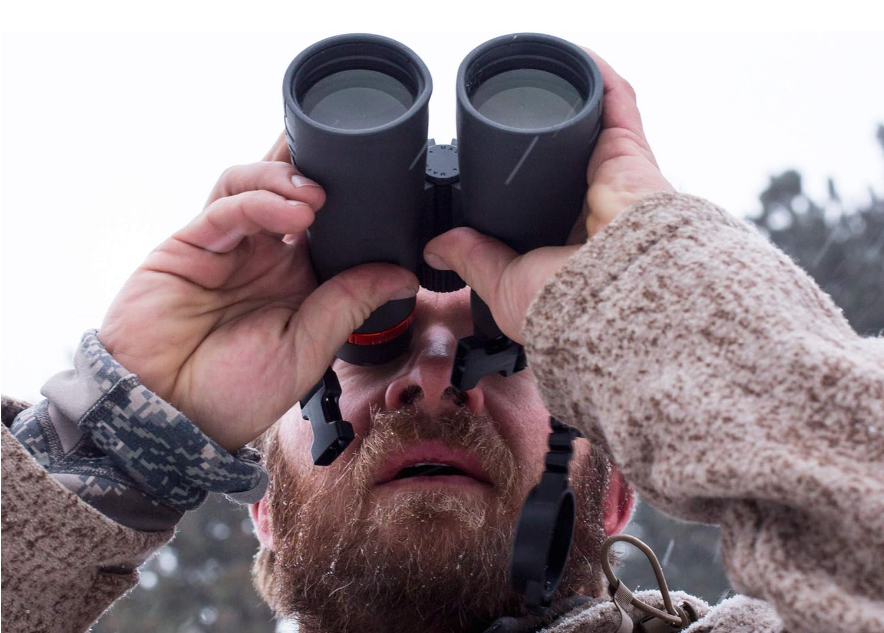Are you looking for the best 10×50 binoculars for astronomy? If so, you are in the right place.
In this buying guide, we’ll walk through what features to look for, what to expect from performance in different sky conditions, and then present our top picks for the best 10×50 binoculars suited for astronomy. Whether you’re just getting started or want a solid pair to keep using alongside a telescope, you’ll find something here that fits your sky-watching goals.
Why 10×50 Binoculars are Ideal for Astronomy
10×50 binoculars strike an exceptional balance between magnification, brightness, and portability, making them one of the most popular choices for amateur astronomers and night-sky enthusiasts.
The 10x indicates ten times magnification, allowing you to see celestial objects in far greater detail than the naked eye, while the 50mm objective lenses gather ample light to illuminate faint stars, nebulae, and galaxies even under dark skies. This combination provides both reach and clarity without the bulk or complexity of a telescope.
Benefits of Binoculars over Telescopes for Beginners
For those just starting in astronomy, binoculars offer a simpler, more approachable, and often more rewarding way to explore the night sky than telescopes. These benefits include:
- Easy to Use. With binoculars, no setup or alignment needed; just point and observe.
- Portable. The best 10×50 binoculars for astronomy are lightweight and compact for quick stargazing anywhere.
- Wide Field of View. This makes locating constellations and celestial objects easier.
- Comfortable Viewing. Furthermore, the two-eyed observation feels natural and reduces strain.
- Affordable. Quality binoculars cost less than beginner telescopes.
How to Stabilize for Steady Views (Handheld vs. Tripod)
To enjoy clear, steady views through your 10×50 binoculars, stability is key.
For handheld use, grip the binoculars firmly with both hands, tuck your elbows against your chest, and lean or sit to minimize shaking. Breathing steadily and using a neck strap can also improve control during longer sessions.
For maximum stability, mount your binoculars on a sturdy tripod using an adapter. This eliminates hand tremors and allows for hands-free, comfortable viewing. While handheld viewing is convenient and portable, a tripod setup provides the clearest, most detailed results during extended stargazing.
Tips for Locating Celestial Objects (Moon, Clusters, Milky Way)
Finding celestial objects becomes much easier when you follow these simple techniques.
- Start with the Moon: It’s the easiest target. Use it to practice focus and steadiness.
- Observe Star Clusters: Look for bright groups like the Pleiades or Beehive Cluster, which are easy to spot even in light-polluted skies.
- Find the Milky Way: Go to a dark location, let your eyes adjust for 15–20 minutes, and sweep slowly to see star-rich regions.
- Use a Star Map or App: Use guides to locate constellations and objects.
- Scan Slowly: Move the binoculars gently across the sky to reveal hidden details.
- Practice Patience: Allow your eyes to adapt and enjoy the gradual discovery of celestial wonders.
Best 10×50 Binoculars for Astronomy
1.Vortex Optics Diamondback HD 10×50
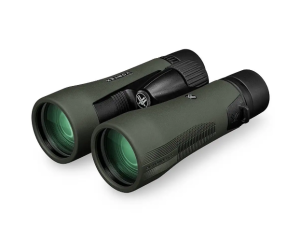
The Vortex Optics Diamondback HD 10×50 binoculars are the best 10×50 binoculars for astronomy. They are designed for outdoor enthusiasts who demand excellent performance without breaking the bank.
Built with a rugged rubber-armored chassis, these binoculars are both durable and comfortable to hold, offering a secure grip even in wet or cold conditions.
Furthermore, the high-definition (HD) optical system delivers bright, crisp, and color-accurate images by minimizing chromatic aberration. With fully multi-coated lenses and dielectric prism coatings, users experience superior light transmission and contrast, even during low-light conditions such as dawn or dusk.
Additionally, the Diamondback HD 10×50 boasts adjustable eyecups, a smooth central focus wheel, and tripod adaptability to enhance usability and comfort during extended viewing sessions. These binoculars are also argon-purged and O-ring sealed, ensuring reliable waterproof and fog-proof performance in all weather conditions.
Features
- Rubber armor
- Multi-layer prism coatings
- Tripod adaptable
- Rugged and shockproof construction
Pros
- Excellent optical clarity with HD glass and multi-coated lenses
- Durable, rubber-armored construction for rugged outdoor use
- Waterproof and fog-proof design ensures all-weather reliability
- Comfortable grip and adjustable eyecups for extended viewing
Cons
- Tight eye relief for users with glasses
2.Fujinon Polaris FMT-SX 10×50
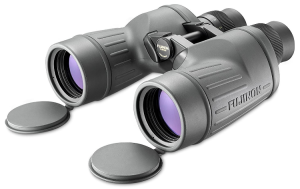
The Fujinon Polaris FMT-SX 10×50 binoculars are a premium optical instrument designed for stargazers, mariners, and outdoor enthusiasts who demand uncompromising clarity and performance.
The selling point of this pair of binoculars is optical finesse. Built with Fujinon’s renowned EBC multi-coated optics, these binoculars deliver exceptional light transmission and razor-sharp image quality, even in low-light or twilight conditions.
Furthermore, the 10x magnification combined with a wide 50mm objective lens provides bright, detailed, and high-contrast views of celestial bodies or distant landscapes.
Solid construction is another notable feature of these binoculars. The rugged, all-metal construction ensures durability, while the rubber-armored exterior provides a secure grip and resistance against impact, making it a reliable companion in harsh environments.
These binoculars furthermore feature precise optical alignment and an individual focus system, which guarantees excellent image stability and edge-to-edge sharpness. They are also nitrogen-purged and O-ring sealed to ensure they remain waterproof and fog-free even under extreme temperature changes.
Features
- Fold-down rubber eyecups
- Heavy-duty build
- 56 to 74mm interpupillary adjustment range
- Protective rubber armoring
- Individual eyepiece focus
Pros
- Superior optical clarity and brightness with EBC multi-coatings
- Robust, waterproof, and fog-proof construction
- Excellent edge-to-edge sharpness and image stability
- Long eye relief suitable for eyeglass wearers
- Durable metal body with protective rubber armor
Cons
- Premium price point for casual buyers
3.Celestron Outland X 10×50
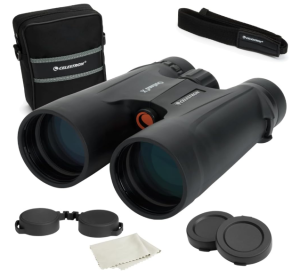
The Celestron Outland X 10×50 binoculars are designed for astronomers who demand excellent performance at an affordable price.
These binoculars feature large 50mm objective lenses combined with 10x magnification, offering bright and crisp images even in low-light conditions. Furthermore, the multi-coated optics deliver impressive light transmission and contrast, while the BaK-4 prisms enhance color fidelity and clarity.
Regarding construction, the rugged, rubber-armored body ensures a secure grip and reliable protection against the elements, making the Outland X a dependable companion for outdoor adventures. Additionally, the binoculars are nitrogen-purged and waterproof, preventing fogging and maintaining clear views in varying weather conditions.
Comfort and usability are also key strengths of the Outland X 10×50. Twist-up eyecups accommodate both eyeglass wearers and non-eyeglass users, ensuring a customizable and comfortable viewing experience. The binoculars also feature a smooth central focus for quick and precise adjustments.
Features
- Multi-coated optics and BaK-4 prisms
- Twist-up eyecups with multiple positions
- Eyeglass-friendly with 17.4mm of eye relief
- Waterproof and nitrogen purged
Pros
- Bright, clear images
- Durable, waterproof, and fog-proof construction
- Comfortable twist-up eyecups for eyeglass wearers
- Easy-to-use central focus wheel
- Excellent low-light performance for dawn or dusk viewing
Cons
- Not tripod-adaptable out of the box. The adapter is sold separately
4.Nikon Aculon A211 10×50
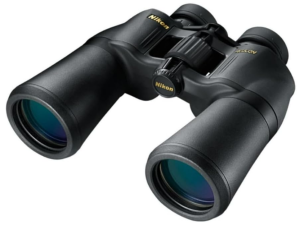
As one of the best 10×50 binoculars for astronomy, the Nikon Aculon A211 10×50 Binoculars are a perfect blend of performance, durability, and affordability.
Designed with Nikon’s signature multicoated eco-glass lenses, these binoculars deliver bright, crisp, and clear images, even in low-light conditions such as dawn or dusk. The 10× magnification provides powerful viewing without excessive hand shake, while the large 50mm objective lenses allow ample light transmission for sharp image clarity.
Furthermore, the wide field of view makes trackin
g moving subjects smooth and effortless, and the ergonomic rubber armor ensures a secure, comfortable grip even during extended viewing sessions.
Built to last, the Aculon A211 10×50 combines sturdy construction with a user-friendly design. The smooth central focus knob allows quick and precise adjustments, and the durable rubber coating provides added shock resistance.
These binoculars are also versatile enough for multiple uses, from stargazing and hiking to sports and travel.
Features
- Aspherical eyepiece lens
- Multilayer-coated lenses for brighter images
- Turn-and-slide rubber eyecups
- Rubber armor for shock-resistance and a firm, comfortable grip
Pros
- Excellent image clarity and brightness with multicoated lenses
- Superior light-gathering ability
- Wide field of view ideal for tracking moving objects
- Comfortable, ergonomic rubber armor grip
- Smooth and precise central focus control
- Durable build with great value for money
Cons
- Not fully waterproof or fog-proof
5.Pentax SP 10×50 WP

If you are looking for the best budget 10×50 binoculars for astronomy, look no further than the Pentax SP 10×50 WP binoculars. They are a rugged and reliable option for outdoor enthusiasts who demand clarity and durability in all weather conditions.
Featuring fully multi-coated optics and BaK-4 prisms, these binoculars deliver sharp, bright images with excellent color fidelity and contrast, even in low-light environments such as dawn or dusk.
The 10× magnification offers impressive reach for stargazing, or long-distance observation, while the 50 mm objective lenses ensure ample light transmission. Furthermore, their rubber-armored body provides a solid, non-slip grip and added protection against bumps or drops, making them ideal for field use or marine applications.
Above all, these binoculars are designed to withstand harsh environments and the focus wheel moves smoothly for quick and precise adjustments.
Features
- Fully multi-coated optics
- Durable aluminum die-cast body
- Soft and foldable rubber eyecups
- Click-stop diopter adjustment
Pros
- Excellent image clarity and brightness
- Fully multi-coated optics with BaK-4 prisms
- Waterproof and nitrogen-filled for fog resistance
- Durable, rubber-armored construction
- Comfortable eye relief suitable for eyeglass wearers
Cons
- Slightly heavy for prolonged handheld use
- No image stabilization feature
6.Maven C3 ED Binocular (10X50)
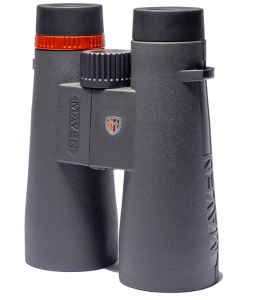
Next, we have the Maven C3 ED Binocular. this powerful binocular features a well-balanced lightweight polymer frame, extra low-dispersion (ED) glass, and fully multi-coated lenses for an exceptionally clear, bright, high-contrast image with excellent color reproduction.
The 10x magnification and 50mm objective lenses provide a wide field of view and excellent light transmission, making it ideal for wildlife observation, hunting, and stargazing.
Regarding construction, its durable polymer frame and scratch-resistant coatings ensure long-term performance, even with repeated use. On top of that, the C3 ED features nitrogen purging and O-ring seals, offering waterproof and fog-proof reliability across different environments.
Comfort and usability are other key highlights of the Maven C3 ED Binocular. The adjustable eyecups and generous eye relief make it suitable for both eyeglass wearers and non-wearers, while the smooth central focus wheel allows for quick and precise focusing. Despite its solid construction, it maintains a balanced feel that reduces hand fatigue during prolonged use.
Features
- Crystal clear extra low-dispersion (ED) glass
- Fully multi-coated lenses
- Durable, yet lightweight polymer frame
- Schmidt-Pechan prism
Pros
- Excellent image clarity and color accuracy with ED glass
- Bright, high-contrast images even in low-light conditions
- Durable, waterproof, and fog-proof construction
- Comfortable handling and balanced weight
- Smooth and precise focusing mechanism
Cons
- Slightly bulkier than smaller objective models
7.Opticron Imagic BGA VHD 10×50
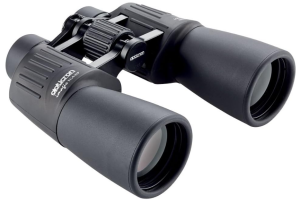
Last but not least, we have the Opticron Imagic BGA VHD 10×50 binoculars. These binoculars are a premium choice for outdoor enthusiasts seeking a balance of clarity, comfort, and durability.
Designed with high-definition optics, they deliver exceptional image sharpness and contrast, even in low-light conditions. The fully multi-coated lenses and phase-corrected prisms ensure vivid color rendition and excellent detail resolution.
Furthermore, these binoculars are built with a robust magnesium alloy body. They are both lightweight and rugged, offering reliable performance in various weather conditions thanks to their waterproof and nitrogen-filled construction.
Comfort and usability are also notable features of the Imagic BGA VHD 10×50. The ergonomic design with rubber armoring ensures a secure, non-slip grip, while the smooth central focusing wheel allows for precise adjustments even when wearing gloves. On top of that, the twist-up eyecups and ample eye relief make them comfortable for both eyeglass and non-eyeglass users.
Features
- Rubber armored body
- Smooth central focus wheel
- Durable and weather-resistant construction
- High-definition optics
Pros
- Outstanding image clarity and brightness with VHD optics
- Rugged yet lightweight magnesium alloy construction
- Fully waterproof and nitrogen-purged for fog-free viewing
- Comfortable grip and smooth focusing mechanism
- Long eye relief suitable for eyeglass wearers
Cons
- Slightly bulky compared to smaller binoculars
- Higher price point than entry-level model
Read Also:
Criteria for Choosing the Best 10×50 Binoculars for Astronomy
When choosing the best 10×50 binoculars for astronomy, several key criteria ensure that you get an instrument capable of delivering bright, clear, and detailed night sky views. Below are six essential factors to consider before making your purchase.
Optical Quality and Lens Coatings
High-quality optics are fundamental for astronomy binoculars. Look for models with fully multi-coated lenses, as these coatings reduce light loss and glare while improving contrast and brightness.
Premium glass types, such as BAK-4 prisms, deliver sharper images and minimize distortion around the edges of the field of view, which is especially important when observing faint celestial objects like nebulae or star clusters.
Field of View (FOV)
A wide field of view allows you to observe larger sections of the night sky and makes it easier to locate and track celestial bodies. For astronomy, a field of view between 5° and 6.5° is ideal, providing an immersive experience without constant repositioning. A broad FOV also enhances comfort during extended observation sessions.
Build Quality and Durability
Furthermore, astronomical binoculars should be built to withstand long-term outdoor use. Choose models with a rugged, rubber-armored exterior that provides a secure grip and protection against accidental drops.
On top of that, the best 10×50 binoculars for astronomy should have a waterproof and fog-proof construction, often achieved with nitrogen or argon purging. This ensures reliable performance in varying weather conditions and prevents internal fogging.
Weight and Ergonomics
Comfort is vital for stargazing, especially during prolonged sessions. While 10×50 binoculars are generally heavier than smaller models, lightweight designs with ergonomic grips or balanced weight distribution help reduce fatigue. If the binoculars are particularly heavy, consider using a tripod adapter for stability and to maintain steady views over time.
Eye Relief
It is also important to consider eye relief. Adequate eye relief, typically 15mm or more, is essential, especially for eyeglass wearers. It enables one to see the full field of view without discomfort.
Eyecup Design
Lastly, look at the eyecup design. The best 10×50 binoculars for astronomy feature adjustable eyecups that enhance comfort and allow customization for users with or without glasses. Comfortable eyecup design also provides a relaxed viewing experience, making long stargazing sessions more enjoyable and less straining.
Best 10×50 Binoculars for Astronomy FAQs
- Are 10×50 binoculars good for astronomy?
Yes, 10×50 binoculars are an excellent choice for astronomy. They offer a perfect balance between magnification and light-gathering ability, making them powerful enough to observe the moon’s craters, Jupiter’s moons, and bright star clusters.
- Can I use 10×50 binoculars without a tripod?
Yes. You can use 10×50 binoculars handheld, but using a tripod or monopod is recommended for extended viewing sessions. The higher magnification can make images appear shaky if held for too long, and a tripod helps keep the view stable and comfortable.
- Can I see planets with 10×50 binoculars?
Yes, you can observe some planets with 10×50 binoculars. The moon, Jupiter, Saturn, and Venus are visible, though you won’t see fine details like planetary rings or surface features.
Final Thoughts
Whether you’re a beginner exploring the Milky Way or an experienced stargazer scanning for nebulae, a well-built pair of 10×50 binoculars offers a portable and immersive way to enjoy celestial wonders. Hopefully, this buying guide has helped you find the right model to experience the night sky in stunning clarity and detail without the complexity of a telescope.

